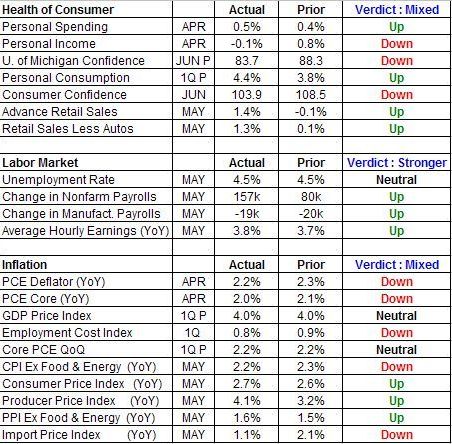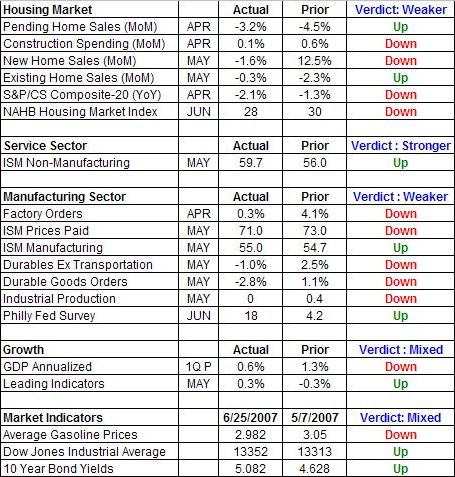| Federal Reserve Meeting: What To Expect for the US Dollar |
| By Kathy Lien |
Published
06/27/2007
|
Currency
|
Unrated
|
|
|
|
Federal Reserve Meeting: What To Expect for the US Dollar
Federal Reserve interest rate announcements have traditionally been big market movers for the US dollar. However in recent months, the market moving-ness of this event risk has been downgraded significantly since the Federal Reserve’s monetary policy has become as predictable as the passage of time.
This Thursday, the Federal Reserve is fully expected to leave interest rates unchanged at 5.25 percent, which would mark a full year since they last raised interest rates. The economic outlook is cloudier this month than last, which means that we could also see a larger currency market reaction. Of course that movement will not be triggered by the rate decision but instead by the accompanying FOMC statement. The key phrases to watch are the ones in reference to the housing market and inflation. A bigger focus on housing market problems will most likely lead to more pronounced dollar weakness against the Euro than the Japanese Yen because the market anticipates another interest rate hike from the European Central Bank this year while shorting USD/JPY would require paying a hefty interest. By the same token, if the tone of the statement remains unchanged, expect USD/JPY to benefit more than the Euro.
For those who want to lay on currency trades going into the meeting, it is important to examine how the economic landscape or data has changed since the last monetary policy meeting in May:
US Economic Data: How Have Things Changed Since the Last Meeting?


As indicated in the data tables above, although theUS consumer continues to keep the economy going by increasing their spending, income growth has been falling. The widening gap between income and spending should be very discouraging for all economy watchers including the Federal Reserve. Despite a stronger labor market, higher stock prices and lower gasoline prices, consumer confidence hit a 10 month low in June. The deterioration in the housing market and the rise in bond yields or mortgage rates have pinched the pocketbooks of US consumers. Whether the dollar will rise or fall on Thursday will now be dependent upon how bad the Federal Reserve thinks the housing market is doing as well whether they believe that core inflation remains “somewhat elevated.” Consumer and producer prices were both up in the month of May and based upon the recent increase in corn and dairy prices as well as the mild change in the US stock market, the Federal Reserve is not likely to loosen their leash on inflation. They know that if they even hinted at the possibility of being less hawkish, the Dow would aim towards 14,000. Although higher stock prices are good for the consumer, the higher the stock market rises the sharper it will fall if the housing market troubles worsen. At this point, the Federal Reserve does not have much choice other than to keep the tone of the statement unchanged in order to tame the stock market bubble.
FOMC Statement: Lines to Watch
When looking at the FOMC statement, the market typically looks for every new word that has been included and excluded from the statement. In the last meeting, there were just a handful of changes. The Fed acknowledged that there was weakness in growth in the “first part of the year,” injected some question as to whether the economy will continue to expand at a moderate pace and confidently acknowledged that core inflation remains somewhat elevated. Their predominant policy concern at the time was still “the risk that inflation will fail to moderate as expected.” The combination of a weak dollar and record average gasoline prices gave the Fed no choice but to continue to lean harder on inflation. Although growth data warrants more cautionary comments, the Fed will most likely wait for a few more weeks of data to ensure that the deterioration in growth is continuing before they drastically change the tune of their statement. Their next monetary policy meeting is in early August. Team Bernanke has often put inflation ahead of growth and for the time being, we do not expect this to change. The futures curve is not pricing in a rate cut at all this year. Keeping interest rates steady and the statement unchanged will be taken positively by the foreign exchange market, which could lead to a resumption of the uptrend in USD/JPY. A surprisingly neutral or dovish statement on the other hand will send the EUR/USD back towards its all-time highs. Either way, be prepared for some active trading on Thursday.
Comparing the FOMC Statements
May 9, 2007
The Federal Open Market Committee decided today to keep its target for the federal funds rate at 5-1/4 percent.
Economic growth slowed in the first part of this year and the adjustment in the housing sector is ongoing. Nevertheless, the economy seems WORD out taken "continued" likely to expand at a moderate pace over coming quarters.
Core inflation remains somewhat elevated. Although inflation pressures seem likely to moderate over time, the high level of resource utilization has the potential to sustain those pressures.
In these circumstances, the Committee's predominant policy concern remains the risk that inflation will fail to moderate as expected. Future policy adjustments will depend on the evolution of the outlook for both inflation and economic growth, as implied by incoming information.
Voting for the FOMC monetary policy action were: Voting for the FOMC monetary policy action were: Ben S. Bernanke, Chairman; Timothy F. Geithner, Vice Chairman; Thomas M. Hoenig; Donald L. Kohn; Randall S. Kroszner; Cathy E. Minehan; Frederic S. Mishkin; Michael H. Moskow; William Poole; and Kevin M. Warsh.
March 21, 2007
The Federal Open Market Committee decided today to keep its target for the federal funds rate at 5-1/4 percent.
Recent indicators have been mixed and the adjustment in the housing sector is ongoing. Nevertheless, the economy seems likely to continue to expand at a moderate pace over coming quarters.
Recent readings on core inflation have been somewhat elevated. Although inflation pressures seem likely to moderate over time, the high level of resource utilization has the potential to sustain those pressures.
In these circumstances, the Committee's predominant policy concern remains the risk that inflation will fail to moderate as expected. Future policy adjustments will depend on the evolution of the outlook for both inflation and economic growth, as implied by incoming information.
Voting for the FOMC monetary policy action were: Ben S. Bernanke, Chairman; Timothy F. Geithner, Vice Chairman; Thomas M. Hoenig; Donald L. Kohn; Randall S. Kroszner; Cathy E. Minehan; Frederic S. Mishkin; Michael H. Moskow; William Poole; and Kevin M. Warsh.
Kathy Lien is the Chief Currency Strategist at FXCM.
|